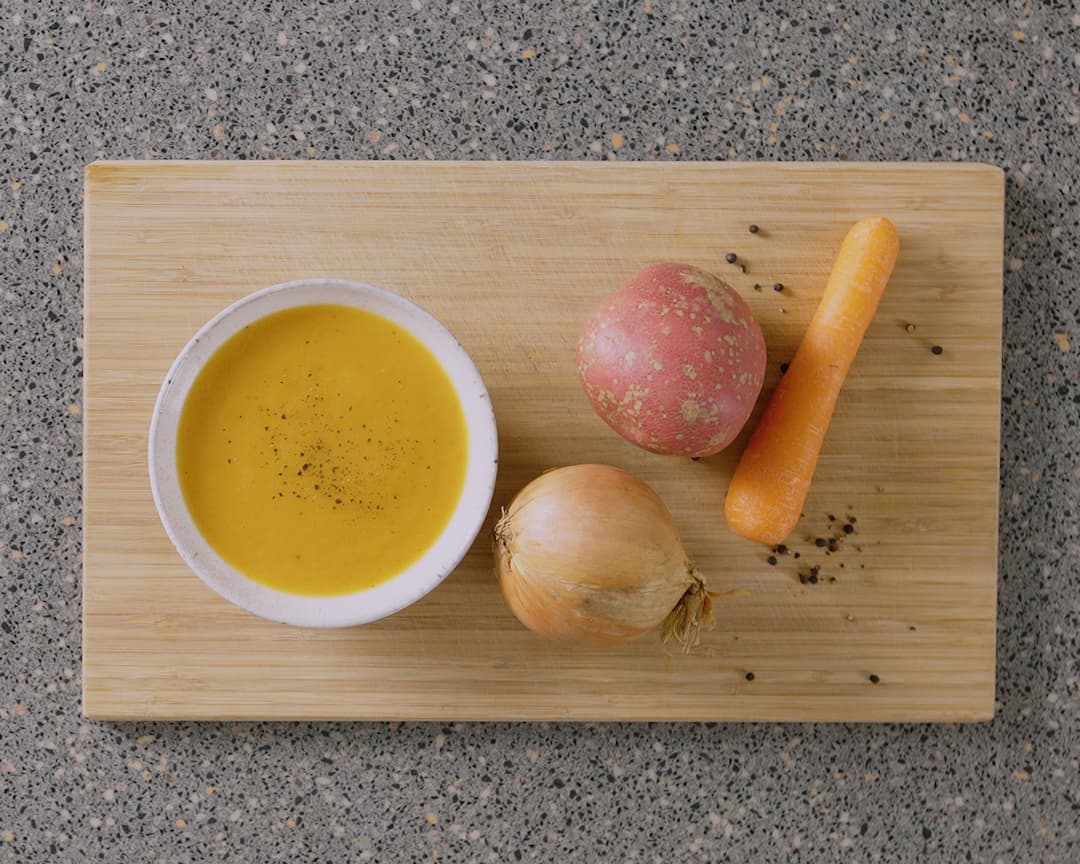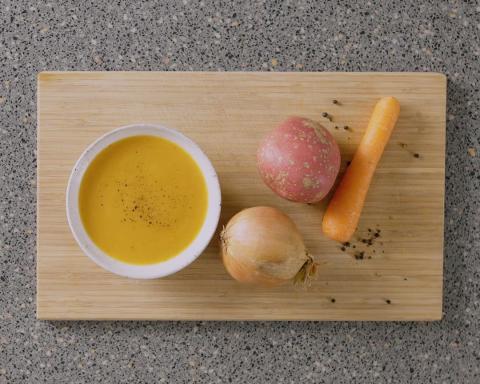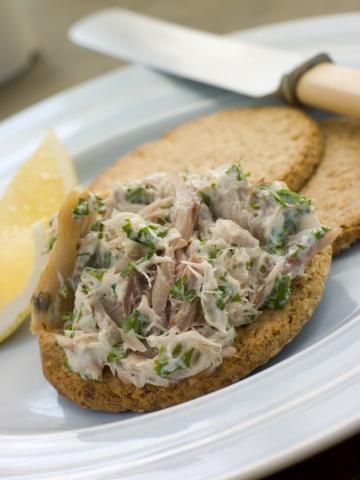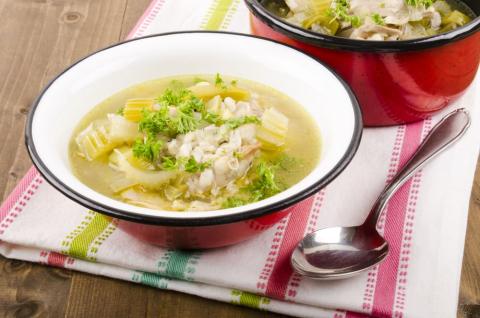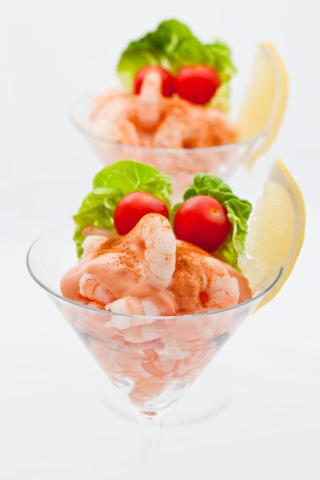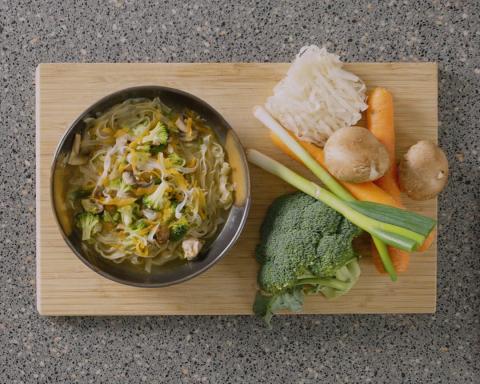- 1 Small (60g) Onion
- ½ Tablespoon (5g) Vegetable Oil
- 1 Large (200g) Potato
- 3 Large (420g) Carrots
- 2 (14g) Vegetable Stock Cubes (use reduced salt when possible)
- 2 Pints (1,200ml) Water
- 2 Tablespoons (30ml) Semi-Skimmed Milk
- 1 Pinch Ground Black Pepper
Ingredients
Allergy Disclaimer
Always check the label of each ingredient for allergy warnings.
Method
- Peel and chop the onions and potatoes and wash and chop the carrots.
- Heat oil in a large pan then add onions and fry until golden.
- Dissolve stock cubes in boiling water then add to the pan along with carrots and potato.
- Bring to the boil, then lower heat and simmer for 30- 35 minutes until vegetables are soft.
- Allow the soup to cool a little and then mash or put through a blender or sieve.
- Add the milk and black pepper to taste then reheat ready to serve. Don't allow the soup to boil as the milk may curdle.
Time Saver Tips
For a quick and easy lunch, why not make the soup in advance and heat it up when required?
Cost Saver Tips
Why not try making twice the amount? That way there’s plenty left to put in the freezer for an easy meal another day. Just remember to let it cool before popping it into the freezer. You can always add in other vegetables, like swede for example, if you have any to use up.
Tips for Kids
How about chopping any vegetables up small or blending them to make them less obvious for your wee one to spot? Your child will love helping you to prepare and chop or mash the vegetables. They might even be more likely to eat it when they know they helped you to make it. Serve the soup with wholemeal bread to boost the fibre content. Try adding spices, such as cumin, curry powder or coriander to add extra flavour - you can always stir these in after serving your wee one if they're not keen.
Nutritional Information
Based on a single serving of 373g (% of an adult's reference intake)
Energy
75 kcals ( 4 %)
320 kJ ( 4 %)
Fat
0.3 g ( 1 %)
Saturates
14.5 g ( %)
Sugar
6.9 g ( 8 %)
Salt
1.5 g ( 25 %)
Detailed nutritional information
| Per 100g | Per 373g serving | |
|---|---|---|
| Energy Kcals | 20 | 75 |
| Energy Kj | 86 | 320 |
| Protein | 0.5 g | 2 g |
| Total Fat | g | g |
| Saturated Fat | 0.1 g | 0.3 g |
| Carbohydrates | 3.9 g | 14.5 g |
| Total Sugars | 1.9 g | 6.9 g |
| NSP Fibre | 0.7 g | 2.7 g |
| Sodium | 165 mg | 612 mg |
| Salt | 0.4 g | 1.5 g |
Find out about nutritional labelling
Nutrition labels on the front of packaging
- Most of the big supermarkets and many food manufacturers display nutritional information on the front of pre-packed food.
- Front of pack nutrition labels provide information on the number of grams of fat, saturated fat, sugars and salt and the amount of energy (in kJ and kcal) in a serving or portion of a recipe.
- The labels also include information about reference intakes (expressed as a percentage) which are guidelines about the approximate amount of particular nutrients and energy required for a healthy diet.
- The colour coding tells you at a glance if the food has high (red), medium (amber) or low (green) amounts of fat, saturated fat, sugars and salt.
- The more greens on the label, the healthier the choice
- Amber means neither high nor low, so you can eat foods with all or mostly ambers on the label most of the time.
- Reds on the label means the food is high in that nutrient and these are the foods we should cut down on. Try to eat these foods less often and in small amounts.
Food shopping tips
If you’re trying to decide which product to choose, check to see if there's a nutrition label on the front of the pack. This will help you to quickly assess how your choices stack up. You will often find a mixture of red, amber and green colour coding for the nutrients. So when you're choosing between similar products, try to go for more greens and ambers and fewer reds if you want to make a healthier choice.
 Activities & Play
Activities & Play Behaviour
Behaviour Childcare
Childcare Development & Growing Up
Development & Growing Up Family, Friends & Relationships
Family, Friends & Relationships Feeding Your Baby
Feeding Your Baby Food & Eating
Food & Eating Health & Safety
Health & Safety Mental Health & Wellbeing
Mental Health & Wellbeing Money & Work
Money & Work Online Behaviour & Safety
Online Behaviour & Safety Pregnancy & First Days
Pregnancy & First Days School & Education
School & Education Sleep
Sleep

